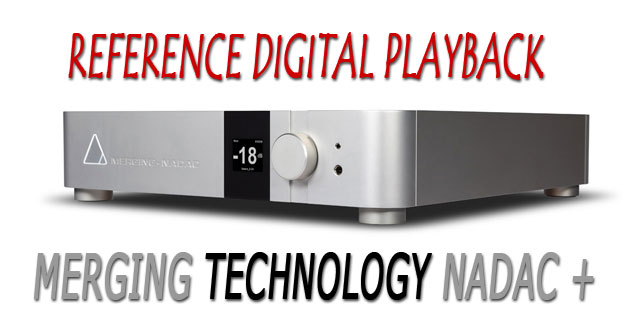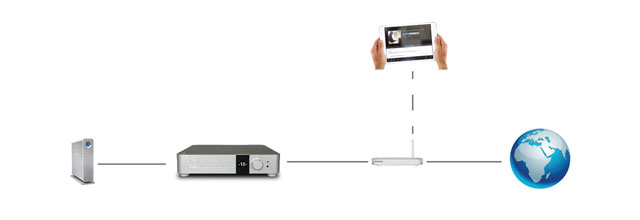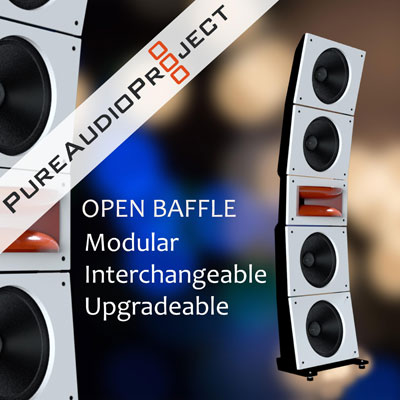Merging Technology NADAC + Player and NADAC + Power Active

 Merging Technologies is one of the world’s leading manufacturer of high-resolution digital audio recording systems over the last 25 years. Merging Technologies was founded in 1990 in Chexbres, Switzerland by Claude Cellier; an electronics graduate of the Institute of Technology in Lausanne and who formerly was employed by the Swiss audio maker Nagra. Not long after the formation of Merging, Merging developed their Pyramix Virtual Studio which was one of the first companies to produce a DSD recording system. Merging Technologies has been developing solutions for DSD since the inception of the Super Audio CD in 1999 and has been delivering ever-improving DSD recording and processing systems for the professional audio community. The DXD format, (Digital eXtreme Definition) which works at 352.8kHz/24bit, was developed by Merging Technologies in collaboration with Philips, to overcome the challenges in editing and mastering DSD for SACD.
Merging Technologies is one of the world’s leading manufacturer of high-resolution digital audio recording systems over the last 25 years. Merging Technologies was founded in 1990 in Chexbres, Switzerland by Claude Cellier; an electronics graduate of the Institute of Technology in Lausanne and who formerly was employed by the Swiss audio maker Nagra. Not long after the formation of Merging, Merging developed their Pyramix Virtual Studio which was one of the first companies to produce a DSD recording system. Merging Technologies has been developing solutions for DSD since the inception of the Super Audio CD in 1999 and has been delivering ever-improving DSD recording and processing systems for the professional audio community. The DXD format, (Digital eXtreme Definition) which works at 352.8kHz/24bit, was developed by Merging Technologies in collaboration with Philips, to overcome the challenges in editing and mastering DSD for SACD.
The MERGING+NADAC’s line outputs are driven by an ESS9008S SABRE Reference Audio D/A integrated circuit. This integrated circuit has 8 separate D/A converters and in the stereo version of the MERGING+NADAC, each channel uses 4 D/A converters with the outputs summed in order to provide improved linearity, greater dynamic range and a lower noise floor. According to MT, careful circuit layout and component selection, refined by many hours of listening tests, has enabled the highest level of performance from this configuration. The headphone output uses the same type of converter integrated circuit that is configured in the same manner.


MERGING+PLAYER has standard digital inputs: AES/EBU on an XLR connector and SP/DIF on RCA and TOSLINK optical connectors. This allows it to be used with almost any CD player or CD transport. For use with computer-based sources, the MERGING+PLAYER uses an Ethernet interface, which allows data to be transferred from the computer to the MERGING+NADAC using the RAVENNA network technology that was developed for professional products and is non-proprietary. It also provides a very high data capacity which permits the precisely timed, error-free transfer of audio data among multiple devices, regardless of the number of participating devices. As tested by MT, one Ethernet cable can transfer 48 channels of DSD256 (transferring just two or eight channels is well within the system’s capability). The use of RAVENNA requires application software installed on the source computer, which allows the MERGING+NADAC to talk to the computer supplying the digital audio signal and control the rate at which the data is sent. The incoming data is read into a large memory buffer in the MERGING+NADAC and then clocked out using the MERGING+NADAC’s precision internal clock.
The MERGING+NADAC has balanced and unbalanced analogue outputs that can be connected to any standard Pre-amplifier, Power Amplifier, or even directly to Powered Loudspeakers. The output level is adjustable via a front panel rotary control with the ability to driving a power amplifier directly (as tested in my system). Headphone outputs are provided via front panel mounted 3.5mm and ¼ inch jack sockets. The front panel rotary control provides independent adjustment of the analogue output level and headphone output level while depressing the control gives access to the various system configuration parameters (source, 2CH/8CH, polarity, channel balance). The MERGING+NADAC also has a built-in web server for remote control from any web browser, tablet or smart phone, when the unit is used with a computer based music source. The MERGING+NADAC must be connected to a Gigabit Ethernet port or switch to activate this feature. A variety of other features can be selected within Roon’s DSP settings including upsampling, filtering and roll-off for DSD.


The MERGING+NADAC connects through the network with Ethernet/RAVENNA to:
- Any Windows Server/Player/Streamer through ASIO
- Any MacOS Server/Player/Streamer through CoreAudio
- Any Linux Server/Player/Streamer through ALSA. we recommend our Roon integrated MERGING+PLAYER
ANALOG OUTPUTS
- 8/2 Balanced on 3-pin male XLR
- 8/2 Unbalanced RCA Phono connectors
- Separate headphone sockets with 1/4″ jack and mini-jack ( when connected to a network, the headphones and main outputs may be driven by different source if required)
DIGITAL INPUTS
- Ethernet (RAVENNA/AES67) on RJ45 connector. Accepts 44.1kHz – 384kHz PCM, DXD, DSD 64, DSD128, DSD256
- Connects from the computer using standard ASIO on Windows and CoreAudio on Mac
- Allows cable runs up to 100m on a single Cat5e or Cat6 cable, with possible repeaters, hubs or switches
- Asynchronous communication. The MERGING+NADAC controls the rate at which the digital audio data is sent to the DAC, not the computer or the player
- Ultra-precise communication clocking driven by the DAC…. Precision Time Protocol is at the heart of RAVENNA, ensuring a clock resolution of one nanosecond
- AES/EBU on 3-pin female XLR connector (44.1kHz – 192kHz PCM)
- SPDIF Optical on Toslink connector (44.1kHz – 96kHz PCM)
- SPDIF Coaxial on RCA Phono (44.1kHz – 96kHz PCM)
ADDITIONAL INPUTS
- Word Clock Input. BNC connector
- DC Power Supply Input (not available for MERGING+PLAYER)
- MERGING+PLAYER offers two additional USB ports to connect music libraries on USB drives or memory sticks and allow for maintenance and system recovery.
 The MERGING+PLAYER and Merging + Power arrived in a single flight case. Both chassis have the same overall dimensions and appeared massive in comparison to my current reference. The chassis work of both components exudes quality and a high level of craftsmanship. It’s quite the piece of audio jewelry. In my system, I connected the MERGING+PLAYER and MERGING+POWER directly to my NAT Transmitter monoblocks and used the MERGING+PLAYER to control the output volume. The installation of Roon on my 3rd generation iPad to act as a remote was unsuccessful. Upon further examination, Roon requires the 11.0 operating system which is found on the more recent iPad platforms. The installation of Roon on my laptop required the updating my laptop operating system to Windows 10. For the entire review period, the loading and playing of music through Roon was entirely done through my HP laptop. There was one instance where control of the volume on my laptop created a maximum volume condition so throughout the review, the volume was controlled through the front chassis rotary control on the MERGING+PLAYER. There are also a couple of USB slots which I tested successfully, that can be used with a hard drive or USB stick, thus eliminating the need to have an external NAS drive.
The MERGING+PLAYER and Merging + Power arrived in a single flight case. Both chassis have the same overall dimensions and appeared massive in comparison to my current reference. The chassis work of both components exudes quality and a high level of craftsmanship. It’s quite the piece of audio jewelry. In my system, I connected the MERGING+PLAYER and MERGING+POWER directly to my NAT Transmitter monoblocks and used the MERGING+PLAYER to control the output volume. The installation of Roon on my 3rd generation iPad to act as a remote was unsuccessful. Upon further examination, Roon requires the 11.0 operating system which is found on the more recent iPad platforms. The installation of Roon on my laptop required the updating my laptop operating system to Windows 10. For the entire review period, the loading and playing of music through Roon was entirely done through my HP laptop. There was one instance where control of the volume on my laptop created a maximum volume condition so throughout the review, the volume was controlled through the front chassis rotary control on the MERGING+PLAYER. There are also a couple of USB slots which I tested successfully, that can be used with a hard drive or USB stick, thus eliminating the need to have an external NAS drive.
The Sound
In my system I ran the MERGING+PLAYER and MERGING+POWER directly into my NAT Audio Transmitter monoblocks. I found the volume control to perform flawlessly with excellent bass extension and power reserve. I never had to turn the volume above 35% of the maximum output to experience everything the MT NADAC had to offer.
 Bossa Antigua (RCA Victor), another hidden gem in my jazz recording collection, is jazz with a latin feel album by American jazz saxophonist Paul Desmond that was recorded back in 1964. Desmond is better known as the writer of Take Five. The album title is a kind of pun: Bossa Antigua (“old thing”) in contrast to the popular musical genre Bossa Nova (“the new thing”). Bossa Antigua picks up the samba-based rim shots of drummer Connie Kay on Take Ten and tries to make a whole new record out of them. There’s a mixture of themes with tracks like “Samba Cantina” reverting to a typical bossa nova rhythm of the period, which leads one to conclude that “bossa antigua” is merely whatever Desmond says it is. My favorite track, “A Ship Without a Sail” has some memorable off-the-cuff solo ideas. Desmond’s sax is instantly recognizable with his pairing here with another distinctive player, the iconic guitarist Jim Hall. The MERGING+PLAYER and MERGING+POWER had a “knack” for capturing the scale of the ensemble precisely as it was recorded. The blackness of acoustical space between the instruments and the clarity of each instrument was breath taking in such as way you would not guess that was in the original recording. One of the most significant aspects of the MT NADAC system that resonated with me was the silence between notes that inspired further investigation. In comparison, all of these strengths mentioned above were not displayed to this extent with my current digital reference.
Bossa Antigua (RCA Victor), another hidden gem in my jazz recording collection, is jazz with a latin feel album by American jazz saxophonist Paul Desmond that was recorded back in 1964. Desmond is better known as the writer of Take Five. The album title is a kind of pun: Bossa Antigua (“old thing”) in contrast to the popular musical genre Bossa Nova (“the new thing”). Bossa Antigua picks up the samba-based rim shots of drummer Connie Kay on Take Ten and tries to make a whole new record out of them. There’s a mixture of themes with tracks like “Samba Cantina” reverting to a typical bossa nova rhythm of the period, which leads one to conclude that “bossa antigua” is merely whatever Desmond says it is. My favorite track, “A Ship Without a Sail” has some memorable off-the-cuff solo ideas. Desmond’s sax is instantly recognizable with his pairing here with another distinctive player, the iconic guitarist Jim Hall. The MERGING+PLAYER and MERGING+POWER had a “knack” for capturing the scale of the ensemble precisely as it was recorded. The blackness of acoustical space between the instruments and the clarity of each instrument was breath taking in such as way you would not guess that was in the original recording. One of the most significant aspects of the MT NADAC system that resonated with me was the silence between notes that inspired further investigation. In comparison, all of these strengths mentioned above were not displayed to this extent with my current digital reference.
 I recently discovered a new band that is a mixture of jazz and new world known as “House of Waters”. House of Waters has scored an Emmy winning documentary from ESPN and has shared the stage with some of the most influential music leaders such as Pandit Ravi Shankar, Victor Wooten, Tinariwen, Jimmy cliff, Snarky Puppy, and Karsh Kale. Their latest release from 2016, House of Waters (GroundUP LLC) which debuted at #2 on the iTunes World Music Charts, has been getting its share of play time in my system. With Max ZT on the hammered dulcimer, Moto Fukushima on the bass, and Ignacio Rivas Bixio on the drums, “House of Waters” resonates throughout with a true eclecticism drawing its influences from many sources. Playback through the MERGING+PLAYER and MERGING+POWER on my favorite cut, “Black Mallard” brought this entire arrangement to life while handling dynamics with aplomb. The accuracy of image placement within the soundstage and the ability to retrieve details within the recording was the best I have ever heard from a digital source.
I recently discovered a new band that is a mixture of jazz and new world known as “House of Waters”. House of Waters has scored an Emmy winning documentary from ESPN and has shared the stage with some of the most influential music leaders such as Pandit Ravi Shankar, Victor Wooten, Tinariwen, Jimmy cliff, Snarky Puppy, and Karsh Kale. Their latest release from 2016, House of Waters (GroundUP LLC) which debuted at #2 on the iTunes World Music Charts, has been getting its share of play time in my system. With Max ZT on the hammered dulcimer, Moto Fukushima on the bass, and Ignacio Rivas Bixio on the drums, “House of Waters” resonates throughout with a true eclecticism drawing its influences from many sources. Playback through the MERGING+PLAYER and MERGING+POWER on my favorite cut, “Black Mallard” brought this entire arrangement to life while handling dynamics with aplomb. The accuracy of image placement within the soundstage and the ability to retrieve details within the recording was the best I have ever heard from a digital source.
I was able to experience one DSD recording as supplied by Merging Technologies’ USA Distributor. The music being made (and not reproduced) in my room was something I’ve never experienced before. The performance was displayed with overwhelming power and sounded incredibly real and accurate with the back wall completely absent in each recording. I have never heard this level of resolution and the rendering of the actual recording space as portrayed by the MERGING+PLAYER and NADAC.
Compared to my tube based Ayon Audio S-5 Network Player/DAC/Preamp, the MERGING+PLAYER and MERGING+POWER had greater image focus, had greater clarity in the higher frequencies, displayed more depth, a lower noise floor and tended to projected the soundstage behind the front plane of my Tekton Design Double Impact SE loudspeakers where as Ayon Audio S-5 excelled at image bloom, presence, tonal color, dynamics, and projecting the soundstage beyond the front plane of my loudspeakers, as one would expect when comparing a solid state vs a tube based digital system. I could easily live with either in terms of the overall sound quality. The advantage of the Ayon Audio S-5 is the convenience of a single remote that can access music files directly from an NAS drive from my listening chair vs having to search and load music files on the MERGING+PLAYER. If I had to pick between the digital two sources, I would choose the MERGING+PLAYER and MERGING+POWER because of its ability to render DSD Audio so well and its overall musicality. Bear in mind, given the price of admission of the MERGING+PLAYER and MERGING+POWER, one would expect the Merging duo to outperform my current digital reference.
Conclusion
The combination of the inclusion of the Roon Core, the DSD capability, the ability to be incorporated into a network via its Ravenna Ethernet protocol, and it’s SOTA audio performance as a digital source sets the MERGING+PLAYER and MERGING+POWER apart from other Powered DACs in the markets place. DSD playback on the Merging Technologies system really floated my boat. I’m now in the market for the latest Merging Technologies product.


Mike Girardi
MERGING+PLAYER PL8, $13,500
Website:www.nadac.merging.com
Stereo Times Masthead
Publisher/Founder
Clement Perry
Editor
Dave Thomas
Senior Editors
Frank Alles, Mike Girardi, Key Kim, Russell Lichter, Terry London, Moreno Mitchell, Paul Szabady, Bill Wells, Mike Wright, Stephen Yan, and Rob Dockery
Current Contributors
David Abramson, Tim Barrall, Dave Allison, Ron Cook, Lewis Dardick, Dan Secula, Don Shaulis, Greg Simmons, Eric Teh, Greg Voth, Richard Willie, Ed Van Winkle, and Rob Dockery
Music Reviewers:
Carlos Sanchez, John Jonczyk, John Sprung and Russell Lichter
Site Management Clement Perry
Ad Designer: Martin Perry






Be the first to comment on: Merging Technology NADAC + Player and NADAC + Power Active